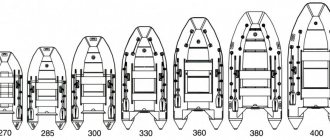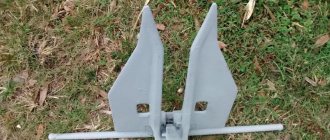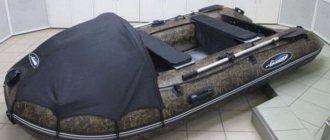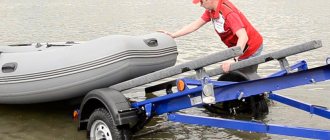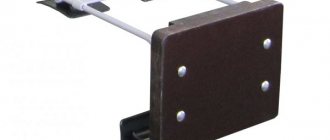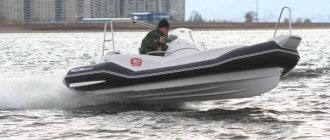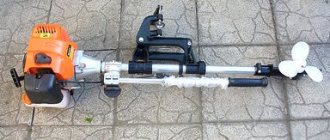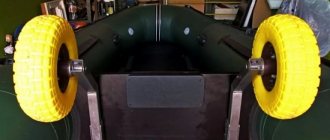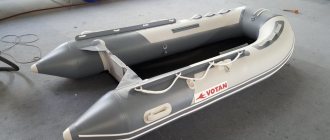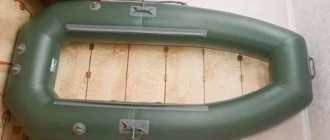23 Nov 2015 Published in Boats |
( 8 votes, average: 4.00 out of 5)
Hi all! Today I want to raise the painful topic of boat anchors . I will touch on many questions, and I will try to answer them briefly and as clearly as possible.
Collecting fishing gear
Fishing equipment for catching fish in a retrieve must combine not only the design and installation of equipment (rod, line, hooks, sinker, float, reel) but also knowledge of other aspects (bait, feeding). Let's take a closer look at them, since the correct design for wiring is the main tool.
Rod selection
To fish with this method, you need a rigid and at the same time light stick, for example, a telescope 4-5 meters long, equipped with rings. They make it easier to unwind the fishing line, turning the fishing process into a comfortable experience. Feeder rods have also proven themselves to be good on retrieves, and the leger type is the best. Quite tough and light, they can withstand playing large fish and do not tire your hand. The optimal length of such rods is 360-390 cm.
Line selection
For fishing in the wire, the tackle is equipped with a main vein 0.22-0.3 mm thick (100-150 meters), to which a leash with a fishing line diameter of 0.14-0.2 mm and a length of up to 40 cm is attached using a swivel. The equipment allows the tackle be more catchy, and in case of a snag, only the leash is lost.
Coil selection
For this fishing method, you can choose any modification depending on how comfortable it is for the fisherman to use. When you first try to learn how to catch trophy specimens using the reeling method, you can get by with inertia-free models, which are in the arsenal of all fishermen. Reels of this type are good for long, precise casting and when fishing in inconvenient places.
The advantages of coils are:
- simplicity and accuracy of casting over long distances;
- ability to quickly reel out fishing line;
- the presence of a friction brake, which reduces the number of gear breaks.
The main disadvantage is the lack of easy descent of the fishing line. Over time, you can switch to inertial types, which, when winding, prevent the veins from twisting, and when wiring, gently lower them, guaranteeing constant tension. The advantages of such reels:
- uniformity of line descent;
- absence of circles between the float and the rod on the water surface;
- ease of vein control;
- accuracy of casting into hard-to-reach places and when fishermen are crowded;
- minimal formation of “beards” when delivering bait.
To learn more:
Mainline boilies for carp fishing
Float selection
Since wire fishing is carried out in the current, the buoys must ensure the smoothest possible movement of the equipment in the fishing areas and clearly indicate the moment of the bite. Such requirements are satisfied by models attached to the fishing line at the top and bottom. Floats with a long keel (guaranteed stability in currents and strong winds) and antennas in bright colors (they are visible when casting over long distances) are suitable for use.
These floats are appropriate in cases where fishing by wire is carried out at depths comparable to the length of the fishing rod. In other conditions, it is appropriate to use sliding structures.
Sinker selection
The optimal installation for weighting fishing tackle is to mount several lead peas below the float. The heaviest one is placed under the bite indicator, then a smaller droplet, and the lightest one at a distance of 10-15 cm from the hook. This is the best design for cases when fishing in the current takes place.
You can also load the tackle with one sliding-type lead droplet. Such equipment is appropriate when casting over long distances. The disadvantage is low sensitivity and lack of good “play” of the nozzle.
Requirements for hooks
The Bolognese fishing rod for retrieving requires careful selection of the tip for the nozzle. Preference depends not only on the size of possible trophies, but also on the size of the bait. For example, for maggots, a point with an extended fore-end No. 12-14 would be acceptable. Accordingly, for a leech or a worm you will need a larger size. Regardless of the size and shape, the hooks must be strong and sharp in order to reliably hook the fish and not lose it during the fishing process.
Selecting a nozzle type
Maggot has proven itself to be a stable bait that works in different weather conditions for wire fishing. Based on the size of the hooks, 3-5 larvae are placed on them, piercing the edge of the head with the tip. It is advisable to hide a sting in one of the maggots.
The bloodworm proved to be no less catchy bait. But before fishing in the retrieve on the river (Oka, Buzan, Volga, Don) or other waters, you must remember that this bait is quite delicate and cannot withstand more than one cast. Bloodworms are also a very consumable bait, but as part of a “sandwich”, supplemented with maggot larvae, it promotes good results.
Directly near the fishing spot you can find burdock caterpillars, bark beetle larvae and caddis flies. Such baits work well in the spring and not only attract fish, but also give them a wild appetite. Knowing the habitats of larvae and caterpillars, you can save tens of rubles.
To learn more:
Characteristics of the Soyka-3 bite alarm
Vegetable baits are also used for wire fishing. Some fish species, such as ide and roach, prefer them. At home, you can prepare pearl barley and rolled oats, boil peas and semolina porridge. Sometimes even balls of white bread crumb become a delicacy for fish.
Choice of bait
When planning to fish with a wire, it is not necessary to stock up on a large number of baits that attract fish. But it is also impossible to say that they will be superfluous. With the help of soaked bread crumbs, pearl barley grains mixed with clay and sand, you can attract a large flock. The main thing in this matter is not to overdo it and not to overfeed the object of the hunt. Otherwise, the satiated river inhabitants will stop responding to any bait.
Anchor for a boat in any current
Another extreme can be called a situation when a strong welded anchor on the principle of an “Admiralty” anchor or similar marine devices perfectly holds a heavy boat in any current, but when it is necessary to move, such an anchor sometimes does not allow this to be done. It can get stuck dead on the bottom of stones or the trunk of a dead driftwood tree. And then you can see how fishermen tug at the anchor caught on the bottom for quite a long time, moving on the motor downstream, then up, then left and right. And such rescue operations to remove the anchor sometimes last quite a long time.
What anchor should you choose for a boat so that this device is reliable and safe during fishing and hiking trips?
Preparing a PVC boat for going out on the water and fishing
Soon the time will come when you can go to the pond for fish on a boat. Explore summer spots, catch new wobblers and rubber with lures, and just have a good time on the water. However, before you put your boat on the water, you need to check its condition. After all, the issue of safety comes first here.
Preparing a PVC boat for going out on the water after winter storage
The polyvinyl chloride (PVC) from which the boats are made does not deteriorate during conservation, even if you leave the boat at the base in a semi-deflated state under the snow, hide it in a cold garage, or throw it on the balcony (ideally kept warm and inflated). The material itself is quite strong and reliable, due to its formula and reinforcement with reinforced threads.
As soon as the season of liquid water arrives, it will be enough to inflate the boat and keep it inflated for about a day. If it does not deflate, then everything is fine and the ship is almost ready for the “big voyage”.
Next, you need to check all the fittings. Make sure everything is in perfect condition. Have the oar holders come unglued? They are usually made of PVC plastic, so it is very difficult to break them due to the properties of the material, but they can easily come off. It’s better to play it safe so as not to find an unpleasant surprise on the pond.
All this is true only for high-quality polyvinyl chloride, and not for cheap “Chinese PVC”, which becomes unusable indecently often, and for any reason. This is exactly the case when “the miser pays twice,” but that’s not what we’re talking about now.
What not to do with a polyvinyl chloride (PVC) boat
Low temperatures are PVC’s Achilles heel.
Some fishermen have the thought in the middle of winter: “Shouldn’t I have my boat checked? The early opening of the spring season is coming soon.” If the boat is hidden in a warm room, then unnecessary disturbance will not harm it. However, if the vessel is in a cold garage, then there is every chance of damage to the hardened material. One of the few vulnerabilities of PVC is low temperatures. Be careful.
Rats ruined the PVC boat
After fishing, any boat should be thoroughly rinsed and dried. PVC does not deteriorate from moisture, like rubber, but it does not have resistance to mouse teeth. Odors from a dirty boat attract rodents.
Wash and dry the boat after fishing, and before storing it, for proper storage of the boat, it is advisable to use the services of a car wash. Let everything be treated with chemicals and shampoos; this procedure should remove the status of a “mouse delicacy” from your watercraft.
In addition, you can treat it with a special rodent spray. Just don't skimp, find a really good one. Otherwise, your “defense” will eat the boat faster than rodents.
Do-it-yourself boat repair
In the era of YouTube, you can do anything yourself. Just go to the application, write there: “how to fix a boat with your own hands..” and get down to business, simultaneously listening to the advice of the video blogger. However, this often leads not to solving the problem, but to increasing its scale.
If you are not sure that you can fix it yourself, it is better to contact a professional. Believe me, qualified repairs will cost much less than buying a new boat.
And if you still decide, then use only high-quality materials, preferably from the repair kit of your particular model. And before work, watch more different videos and articles on how to seal a PVC boat at home. This is one example; you may need to repair some of the fittings; many videos have also been made on this topic.
What should always be in the boat
Now we are not talking about motor boats and other vessels that are subject to registration. If you have a simple PVC boat with oars, then the only thing you need to have with you is a vest. If you have it, there will be no claims against you. However, it would also be a good idea to have a bailer, pump, whistle, flashlight, first aid kit and repair kit with you. All this can come in handy at any time.
How do you prepare your boat for the season?
The 2021 spawning fishing ban has already entered into force, and someone managed to fish on a boat before it began. And everyone else just has to wait until they can go out onto the pond again on their boat and get a spinning rod. There is just time to prepare and modernize the craft. By the way, what do you use to armor the bottom of the boat, PVC or polyurethane film?
Source: https://www.fishingsib.ru/articles/view/120099/
